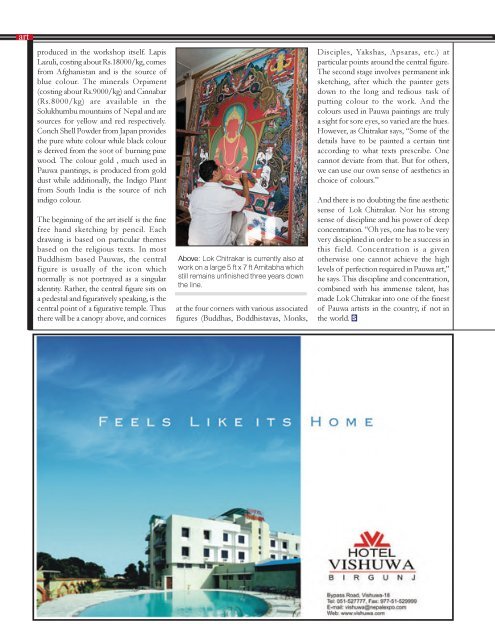Spaces Issue 7
You also want an ePaper? Increase the reach of your titles
YUMPU automatically turns print PDFs into web optimized ePapers that Google loves.
art<br />
produced in the workshop itself. Lapis<br />
Lazuli, costing about Rs.18000/kg, comes<br />
from Afghanistan and is the source of<br />
blue colour. The minerals Orpiment<br />
(costing about Rs.9000/kg) and Cinnabar<br />
(Rs.8000/kg) are available in the<br />
Solukhumbu mountains of Nepal and are<br />
sources for yellow and red respectively.<br />
Conch Shell Powder from Japan provides<br />
the pure white colour while black colour<br />
is derived from the soot of burning pine<br />
wood. The colour gold , much used in<br />
Pauwa paintings, is produced from gold<br />
dust while additionally, the Indigo Plant<br />
from South India is the source of rich<br />
indigo colour.<br />
The beginning of the art itself is the fine<br />
free hand sketching by pencil. Each<br />
drawing is based on particular themes<br />
based on the religious texts. In most<br />
Buddhism based Pauwas, the central<br />
figure is usually of the icon which<br />
normally is not portrayed as a singular<br />
identity. Rather, the central figure sits on<br />
a pedestal and figuratively speaking, is the<br />
central point of a figurative temple. Thus<br />
there will be a canopy above, and cornices<br />
Above: Lok Chitrakar is currently also at<br />
work on a large 5 ft x 7 ft Amitabha which<br />
still remains unfinished three years down<br />
the line.<br />
at the four corners with various associated<br />
figures (Buddhas, Boddhistavas, Monks,<br />
Disciples, Yakshas, Apsaras, etc.) at<br />
particular points around the central figure.<br />
The second stage involves permanent ink<br />
sketching, after which the painter gets<br />
down to the long and tedious task of<br />
putting colour to the work. And the<br />
colours used in Pauwa paintings are truly<br />
a sight for sore eyes, so varied are the hues.<br />
However, as Chitrakar says, “Some of the<br />
details have to be painted a certain tint<br />
according to what texts prescribe. One<br />
cannot deviate from that. But for others,<br />
we can use our own sense of aesthetics in<br />
choice of colours.”<br />
And there is no doubting the fine aesthetic<br />
sense of Lok Chitrakar. Nor his strong<br />
sense of discipline and his power of deep<br />
concentration. “Oh yes, one has to be very<br />
very disciplined in order to be a success in<br />
this field. Concentration is a given<br />
otherwise one cannot achieve the high<br />
levels of perfection required in Pauwa art,”<br />
he says. This discipline and concentration,<br />
combined with his immense talent, has<br />
made Lok Chitrakar into one of the finest<br />
of Pauwa artists in the country, if not in<br />
the world. S<br />
18 NOV-DEC 2005 SPACES

















